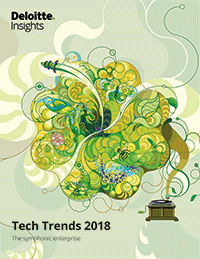Introduction: The symphonic enterprise has been saved

Introduction: The symphonic enterprise Tech Trends 2018
05 December 2017
As digital reality, cognitive, and blockchain continue to redefine IT and business, organizations should look to move beyond vertical or horizontal approaches to new technology. Ideally, strategy, technology, and operations should work together, in harmony, across domains and boundaries.
Learn more
View Tech Trends 2018
Watch the video
Create a custom PDF
Meet our Technology Services Leaders
The renowned German conductor Kurt Masur once noted that an orchestra full of stars can be a disaster. Though we have no reason to believe the maestro was speaking metaphorically, his observation does suggest something more universal: Without unity and harmony, discord prevails.
Many companies competing in markets that are being turned upside down by technology innovation are no strangers to discord. Today, digital reality, cognitive, and blockchain—stars of the enterprise technology realm—are redefining IT, business, and society in general. In the past, organizations typically responded to such disruptive opportunities by launching transformation initiatives within technology domains. For example, domain-specific cloud, analytics, and big data projects represented bold, if singleminded, embraces of the future. Likewise, C-suite positions such as “chief digital officer” or “chief analytics officer” reinforced the primacy of domain thinking.
But it didn’t take long for companies to realize that treating some systems as independent domains is suboptimal at best. Complex predictive analytics capabilities delivered little value without big data. In turn, big data was costly and inefficient without cloud. Everything required mobile capabilities. After a decade of domain-specific transformation, one question remains unanswered: How can disruptive technologies work together to achieve larger strategic and operational goals?
We are now seeing some forward-thinking organizations approach change more broadly. They are not returning to “sins of the past” by launching separate, domain-specific initiatives. Instead, they are thinking about exploration, use cases, and deployment more holistically, focusing on how disruptive technologies can complement each other to drive greater value. For example, blockchain can serve as a new foundational protocol for trust throughout the enterprise and beyond. Cognitive technologies make automated response possible across all enterprise domains. Digital reality breaks down geographic barriers between people, and systemic barriers between humans and data. Together, these technologies can fundamentally reshape how work gets done, or set the stage for new products and business models.
The theme of this year’s Tech Trends report is the symphonic enterprise, an idea that describes strategy, technology, and operations working together, in harmony, across domains and boundaries. This is the ninth edition of Tech Trends, and in a way, it represents the culmination of our dogged efforts to examine the powerful technology forces that are remaking our world. The trends we discussed early on in the series, such as digital, cloud, and analytics, are now embraced across industries. Meanwhile, more recent trends, such as autonomic platforms, machine intelligence, and digital reality, continue to gain momentum.
This year, we invite you to look at emerging technology trends from a different angle. When technologies act in unison, we no longer see the enterprise vertically (focused on line of business or isolated industries) or horizontally (focused on business processes or enabling technologies). In the symphonic enterprise, the old lines become blurred, thus creating a diagonal view that illuminates new business opportunities and creative ways of solving problems. For example, in the new core chapter, we discuss how in the near future, digitized finance and supply chain organizations could blur the lines between the two functions. Sound unlikely? Consider this scenario:
IoT sensors on the factory floor generate data that supply chain managers use to optimize shipping and inventory processes. When supply chain operations become more efficient and predictable, finance can perform more accurate forecasting and planning. This, in turn, allows dynamic pricing or adjustments to cash positions based on real-time visibility of operations. Indeed, the two functions begin sharing investments in next-generation ERP, the Internet of Things, machine learning, and RPA. Together, finance and supply chain functions shift from projects to platforms, which expands the potential frame of impact. Meanwhile, business leaders and the C-suite are increasingly interested only in strategy and outcomes, not the individual technologies that drive them. Does the convergence of finance and supply chain really seem so unlikely?
Of course, some domain-specific approaches remain valuable. Core assets still underpin the IT ecosystem. Cyber and risk protocols are as critical as ever. CIO strategies for running “the business of IT” are valuable and timeless. Yet we also recognize a larger trend at work, one that emphasizes the unified “orchestra” over individual advances in technology.
We hope this latest edition of Tech Trends helps you develop a more in-depth understanding of technology forces at work today. We also hope it can help you begin building a symphonic enterprise of your own. Beautiful music awaits.
© 2021. See Terms of Use for more information.





